

Ahupua`a - Hawaii History - Ahupua`a. Ahupua`a The concept of private property was unknown to ancient Hawaiians, but they did follow a complex system of land division.
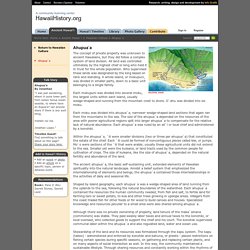
All land was controlled ultimately by the highest chief or king who held it in trust for the whole population. Who supervised these lands was designated by the king based on rank and standing. A whole island, or mokupuni, was divided in smaller parts, down to a basic unit belonging to a single family. Each mokupuni was divided into several moku, the largest units within each island, usually wedge-shaped and running from the mountain crest to shore. Hawai'i and Native Hawaiians - What You May Not Know. Native Hawaiians tried to fight back through the U.S.
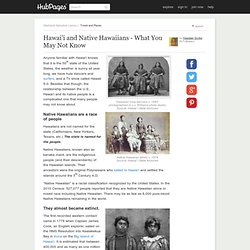
“legal process”. Hawai’i became a U.S. protectorate while an investigation was done by U.S. President Grover Cleveland at the written request of Lili'uokalani. Cleveland and his administration concluded that the overthrow had been illegal (“a grievous wrong has been done…”). He turned the issue over to Congress where it languished while the “straw government” in Hawai’i, who now had Sanford Dole as its President, continued to gain a stronger hold over the islands. Meanwhile, Native Hawaiians launched a massive petition drive to stop the formal annexation of Hawai’i to the U.S. Lili'uokalani traveled to Washington D.C. to present her protest and the petition to Congress. Hawai’i was annexed as a U.S. territory in 1898, along with 1.2 million acres of Hawaiian crown lands that had belonged to the monarchy and to the nation of Hawai’i.
Wayfinders : Polynesian History and Origin. Hokulea: The Rediscovery | Polynesians: An Oceanic People | European Explorers | Linguistic Evidence/Oral Traditions | Heyerdahl and Sharp | The Archaeological Response | Experimental Voyaging | Introduction.

Grades 6 - 8 - Pacific Islanders in Communications. The Land Has Eyes Lesson Plan How Are Cultures (Particularly Those of Native People Who Are Colonized) Impacted Positively and Negatively by New Dominant Cultures?

Grade Levels: 6-8. Ancient Hawaii. Ancient Hawaiʻi is the period of Hawaiian human history preceding the unification in 1810 of the Kingdom of Hawaiʻi by Kamehameha the Great.
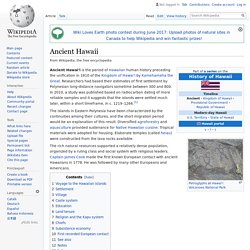
Researchers had based their estimates of first settlement by Polynesian long-distance navigators sometime between 300 and 800. In 2010, a study was published based on radiocarbon dating of more reliable samples and it suggests that the islands were settled much later, within a short timeframe, in c. 1219–1266.[1] The islands in Eastern Polynesia have been characterized by the continuities among their cultures, and the short migration period would be an explanation of this result. Diversified agroforestry and aquaculture provided sustenance for Native Hawaiian cuisine. Tropical materials were adopted for housing. Voyage to the Hawaiian islands[edit] Priests traveling across Kealakekua Bay for first contact rituals. Some writers believe that there were other settlers in Hawaiʻi, peoples who were forced back into remote valleys by newer arrivals.
Teaching Hawaiian Studies: Session 3: Place-Based Learning. Eō nā Wahi Pana o Hawaiʻi(Answer, you celebrated places of Hawaiʻi) What is our relationship to the land?
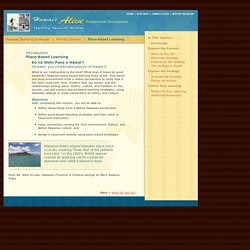
What does it mean be good stewards? Hawaiian place-based learning looks at the ʻāina (land) and local environment from a native perspective to study how it has been used over time, modern land use issues, and the relationships among place, history, culture, and tradition. The Hawaiian Culture - Hawaii History - Hawaiian Culture. A Culture Unfolds The roots of Hawaiian culture stretch south to older areas of Polynesia and beyond to the islands of the Western Pacific and the edges of Asia.

The first settlers to Hawai`i brought with them the more ancient Polynesian traditions and lifestyles. Over generations, they adapted their beliefs and ways of living to accommodate their new island home, adding new gods like Pele to their pantheon and honing new skills such as surfing. As a distinct Hawaiian culture took shape, it grew in response to Oahu's forests and coral reefs, Molokai's shallow offshore waters, Kauai's steep valleys, Maui's high summit and Hawai`i Island's ever-changing volcanic lands.
Differences between Hawai`i and the larger Polynesian family grew more pronounced once the era of transpacific migrations ended. 40 Ways to Teach the 50th Sta... Hawaii celebrated its 40th anniversary of statehood on August 21, 1999!
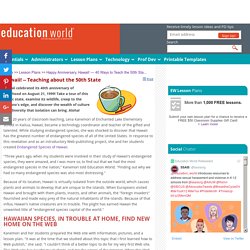
Take a tour of this exotic state, examine its wildlife, creep to the volcano's edge, and discover the wealth of culture and diversity that isolation can bring. Aloha! After 20 years of classroom teaching, Lena Kanemori of Enchanted Lake Elementary School in Kailua, Hawaii, became a technology coordinator and teacher of the gifted and talented. While studying endangered species, she was shocked to discover that Hawaii has the greatest number of endangered species of all of the United States.
In response to this revelation and as an introductory Web-publishing project, she and her students created Endangered Species of Hawaii. "Three years ago, when my students were involved in their study of Hawaii's endangered species, they were amazed, and I was more so, to find out that we had the most endangered species in the nation," Kanemori told Education World. Coral reefs. Kanemori ought to know. Hawaii State Unit Study - Geography, State Symbols & Facts. A Place in the Middle Hawaii Teachers Guide.